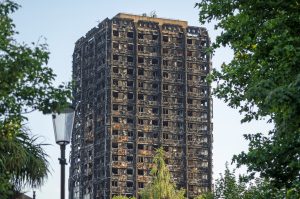David Savage, partner and head of the construction and infrastructure team at Charles Russell Speechlys, examines the final report of the Independent Review of Building Regulations and Fire Safety. Controversially, while recommending a complete overhaul of the current building system for residential tower blocks, the report did not recommend a ban on flammable cladding.
First published on LexisPSL Construction. Click here for a free trial.
What is the purpose of the report?
The report was commissioned by the government with the remit to conduct an independent, in-depth review into building regulations and fire safety, in the wake of the Grenfell fire tragedy in which 72 people died in the greatest loss of life in a fire in a century.
The review focusses on regulations which currently apply to high-rise buildings, and identifies key areas for change. The report’s interim findings were reported in December 2017 (see News Analysis: Interim report on building regulations and fire safety published) and the final report was published on 17 May 2018.
What key issues are identified in the report?
Dame Judith Hackitt’s report identifies ignorance, indifference, lack of clarity on roles and responsibilities, inadequate regulatory oversight, and inadequate enforcement tools as the key culprits for the system’s failures.
The report states that the bar for compliance with building safety requirements is too low, with weak processes, poor record-keeping and change control in many cases. It notes that levels of competence are inconsistent, and that current ‘Approved Documents’ can be ambiguous and inconsistent. Finally, it also identifies the product testing, labelling and marketing regimes as a key issue, with current practices being insufficient, and finds that the voices of residents often go unheard, even where safety issues are concerned.
Dame Hackitt recommends moving away from dictating requirements to responsible duty holders. Her report looks to place those responsible in a position to take ownership and make intelligent decisions about the layers of protection required to keep high-rise residential tower blocks safe.
What key recommendations are made?
The report recommends a complete overhaul of the current system for residential tower blocks. Dame Hackitt recommends that government set up a ‘joint competent authority’ (JCA), comprising local authority building standards, fire rescue authorities and the Health and Safety Executive. A system of mandatory occurrence reporting to the JCA should then be put in place. Non-reporting should be regarded as non-compliance and sanctioned appropriately.
The new framework would include a new, independent body (essentially, a rebranded local authority Building Control) which would approve building safety at design stage and at regular intervals thereafter, and which would have the power to levy hefty fines, issue ‘stop’ notices and even impose prison sentences for non-compliance. Limitation periods for prosecution would be extended. The report also recommends that any private building inspectors used should be independent of builders.
The new regime that Dame Hackitt proposes would only apply to buildings of ten storeys or more. This means current requirements for buildings between six and nine storeys would remain in place, with the changes proposed being relevant only for buildings of ten storeys and above. New buildings should be identified by the local planning authority (LPA) and notified to the regulator, while existing buildings in scope should be identified through other means.
The report also recommends that the new framework treat buildings as a single entity and proposes the publication of a new, ‘over-arching approved document’ which would describe the system as a whole.
Other key recommendations made include:
- that the government identifies the key roles that will be most important in initiating, overseeing or influencing activity throughout the procurement, design and construction phase to ensure increased accountability, and
- where a planning application is made for a high-risk building, the LPA should be required by law to undertake a consultation with the JCA. The same process should apply where planning is sought for another building in the near vicinity (where such building might impact fire service access)
Does the report go far enough?
The review provides a powerful critique of the current regulatory framework and practices within the English construction industry. It identifies key issues with the current system and industry culture, and calls for systematic change and a new regulatory body.
Yet, in many instances, Dame Hackitt has stopped just short of expressly condemning practices which many consider are at the root of the industry’s problems. Notably, the report fails to specifically condemn practices or call for urgent action in respect of combustible materials, desktop studies and materials testing, which many consider essential measures to improving safety.
Despite widespread calls for a ban on combustible materials in cladding systems, the report does not call for this. Dame Hackitt justifies this by stating that a ‘totally prescriptive system’ would create over-reliance on the system and discourage ownership and accountability. She did however indicate that, should the government proceed with a complete ban, she would support this.
Her failure to come down firmly on this matter, alongside other issues, has tainted the report’s reception. The government has now responded by announcing a consultation on the subject of combustibles (see: LNB News 17/05/2018 84), which many find encouraging, but which raises the question—why not recommend a complete ban in the first place? When questioned about exactly this point, Dame Hackitt explained her position as follows:
If people feel that I have not gone far enough, and that for this system to work in the future requires, in addition, that there is further clarity or indeed banning of some of the materials that are being used, I don’t have a problem with that.
What I would be very disappointed about, however, is if people think that simply banning cladding is going to fix this problem—it won’t. It is a broken system and banning cladding on its own will not fix it. If we change the system and implement the new regulatory framework, and take further steps on what cladding is or is not allowed, I don’t have a problem with that at all.
The report does not call for additional oversight to the large-scale cladding testing regime. While it calls for annual reports on tests carried out, it does not suggest that these should be made public. It therefore stops short of a ban which would prevent ‘desktop studies’ from being carried out, but recommends instead that these studies should only be carried out by organisations who are accredited to do so.
The report also stops short of recommending a ban on product substitution, recommending instead a ‘significantly reduced scope for substitution of any products used in a system without further full testing’.
Finally, despite criticism of the current system in place, Dame Hackitt also does not recommend changes to the practice of carrying out ‘category one’ fire risk assessments. Her view is that professional bodies, not government, should decide what a ‘competent person’ is for the purposes of these assessments—although she stops short of recommending compulsory certification.
What do you expect will happen next?
Interested parties seem encouraged by the announcement of the combustibles consultation, though many are frustrated that the report has not included outright condemnation in respect of many of the practices listed above. There are concerns that without the implementation of a ban, further decisive action will fail to follow and the report will be relegated to a pile of previous recommendations without ever effecting serious change in the industry.
It has also been suggested that some of the report’s proposals underestimate the complexity of the task ahead, which would affect the likelihood of their implementation, and Dame Hackitt has provided no clear guidance on how long it would take to bring in this new system.
However, within 24 hours of the report’s publication, James Brokenshire MP, Secretary of State for Housing, Communities and Local Government:
- committed to bringing forward legislation that delivers ‘meaningful and lasting change, and ensures that residents have a much stronger voice in an improved system of fire safety’
- made clear that his Department was consulting on significantly restricting or banning the use of ‘desktop studies’ to assess cladding systems, and confirmed his view that inappropriate use of desktop studies was unacceptable
- indicated that he would not hesitate to ban the use of desktop studies if his Department’s consultation—which closed on 25 May 2018—did not demonstrate that they could be used safely
- confirmed he was working with industry to clarify building regulations fire safety guidance, and would be publishing proposals in this regards for consultation in July 2018
(see LNB News 17/05/2018 84)
Interviewed Max Aitchison. The views expressed by our Legal Analysis interviewees are not necessarily those of the proprietor.
Source: LexisNexis Purpose Built
The Hackitt fire safety report—does it go far enough?



